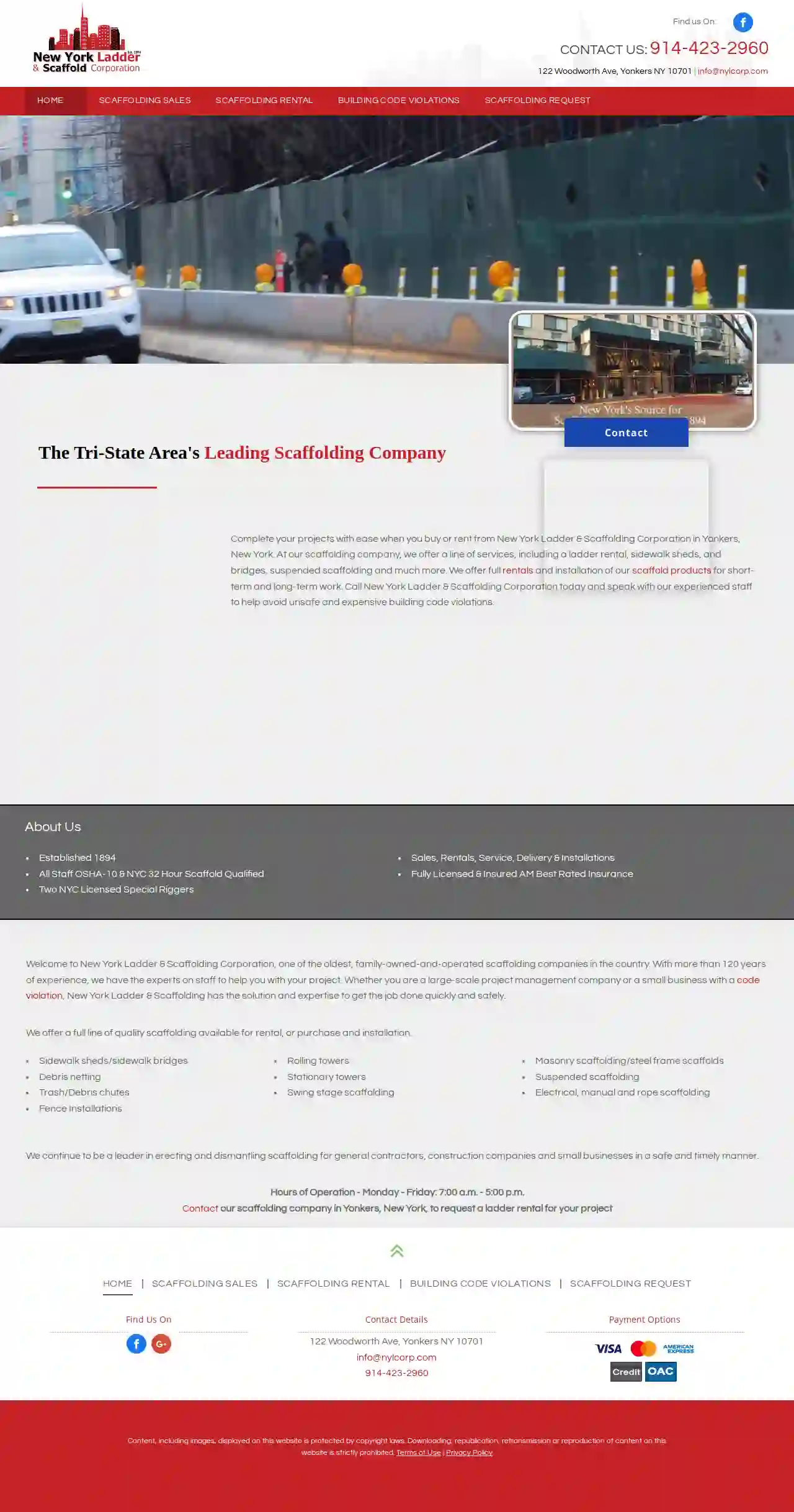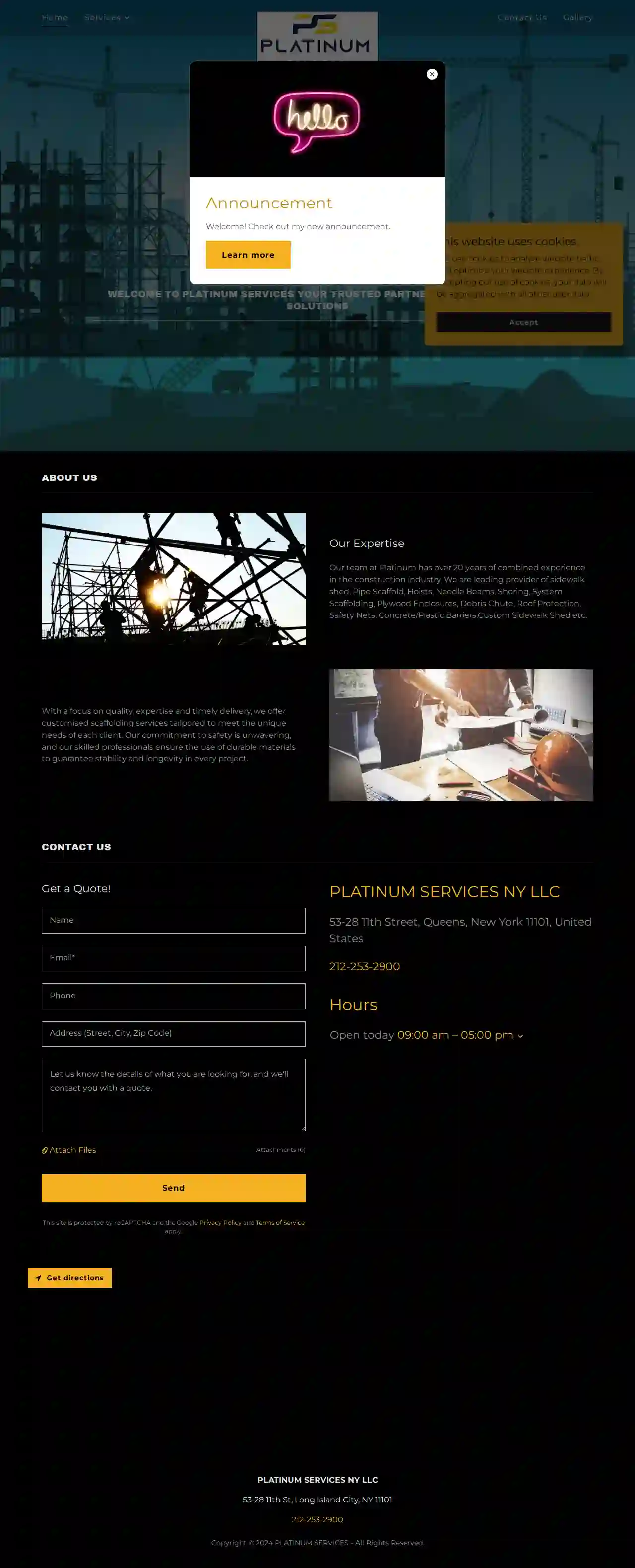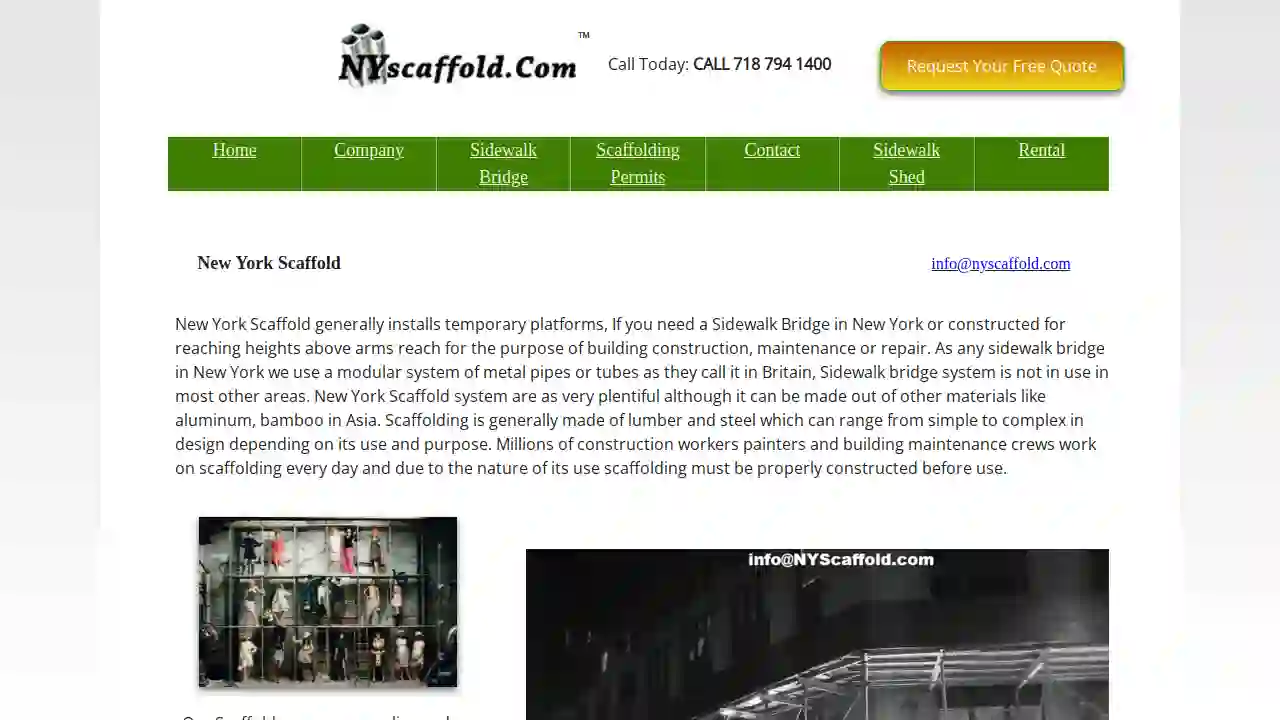Scaffolding Companies Blue Bell
Find top Scaffolding Experts in Blue Bell
Get up to 3 Scaffolding Specialists quotes for your project today! Compare profiles, reviews, accreditations, portfolio, etc... and choose the best service.

New York Ladder & Scaffold Corporation
46 reviews122 Woodworth Ave, Yonkers, 10701, USWelcome to New York Ladder & Scaffolding Corporation, one of the oldest, family-owned-and-operated scaffolding companies in the country. With more than 120 years of experience, we have the experts on staff to help you with your project. Whether you are a large-scale project management company or a small business with a code violation, New York Ladder & Scaffolding has the solution and expertise to get the job done quickly and safely. We offer a full line of quality scaffolding available for rental, or purchase and installation. Our services include sidewalk sheds/sidewalk bridges, debris netting, trash/debris chutes, fence installations, rolling towers, stationary towers, swing stage scaffolding, masonry scaffolding/steel frame scaffolds, suspended scaffolding, electrical, manual and rope scaffolding. We continue to be a leader in erecting and dismantling scaffolding for general contractors, construction companies and small businesses in a safe and timely manner. Our hours of operation are Monday - Friday: 7:00 a.m. - 5:00 p.m. Contact our scaffolding company in Yonkers, New York, to request a ladder rental for your project.
- Services
- Why Us?
- Accreditations
- Gallery
Get Quote
Celtic Scaffolding Company
4.214 reviewsYork, USAt Celtic Scaffold, we specialize in providing top-notch scaffolding services to our clients in New York City. With years of experience in the industry, our team of experts is well-versed in the different types of scaffolds, including pipe scaffolds and hanging or suspension scaffolds. Our pipe scaffolds are stationary and constructed with pipes, erected from the ground up along the side of a building. We ensure that our pipe scaffolds comply with the regulations set by the Construction Division within each borough office of the Department of Buildings (DOB). On the other hand, our hanging or suspension scaffolds are supported from the roof or setback of a building and held by either cables or rope. We contract master riggers or special riggers for the work, and each worker using or operating the suspension scaffold must be employed by the master rigger, special rigger, or their company.
- Services
- Why Us?
- Gallery
Get Quote
Platinum Services
34 reviews53-28 11th St, Long Island City, 11101, USWelcome to Platinum Services, your trusted partner in scaffolding solutions. With over 20 years of combined experience in the construction industry, our team at Platinum has the expertise to provide customized scaffolding services tailored to meet the unique needs of each client. Our commitment to safety is unwavering, and our skilled professionals ensure the use of durable materials to guarantee stability and longevity in every project. We offer a range of services, including sidewalk shed, Pipe Scaffold, Hoists, Needle Beams, Shoring, System Scaffolding, Plywood Enclosures, Debris Chute, Roof Protection, Safety Nets, Concrete/Plastic Barriers, and Custom Sidewalk Shed. Contact us today to get a quote and learn more about our services.
- Services
- Why Us?
- Gallery
Get Quote
West New York Restoration of CT, INC
4.512 reviews1800 Boston Rd, Bronx, 10460, USWest New York Restoration of CT, Inc was founded in 1984 by Principal Alfred Gallicchio with the goal of providing high-quality contracting services in the field of exterior restoration, roofing and waterproofing. The philosophy of the company and its owner is a simple and direct one: to combine experience, management services, and skilled workforce to achieve the highest level of quality for each project. West New York Restoration of CT, Inc.'s key personnel bring a wealth of experience to each project. Whether the problem at hand concerns roofing, waterproofing, masonry, or structural repair, West New York Restoration of CT, Inc. can provide the solution.
- Services
- Why Us?
- Our Team
- Gallery
Get Quote
NY Scaffold
51 reviewsYork, USWe are national scaffold contractors and scaffolding erectors. Experienced NY Scaffold erectors can provide a range of access services for you or your clients, we also take care of any and all NYC DOB Permits. Large and small projects; industrial, commercial and domestic sectors can hire the services of NY Scaffold erectors. No job is too big or too small for us and we have grown our business in the last few years to become one of the leading erectors of scaffolding and sidewalk bridges in the NYC area. Plan your project with complete confidence the sidewalk bridge company NYC can erect scaffolding to all types of structures. NYC installs scaffolds from access towers to bridges and any other type of access equipment that your firm might require. It does not matter how big or how small your project is NY scaffold company NYC will cater to your needs. They have secure access equipment that is perfect for projects in and around the region. Our Scaffolding has several unique safety features that benefit the system’s erectors, users and project inspectors. With eight completely variable component node points and the largest available bay sizes, Our Scaffolding offers the most flexible system. Only five main components are required for basic use and the only erection tools required are a hammer and level. The system’s optimum design offers a high load rating and extreme rigidity, keeping your workers secure and productive. NY Scaffold is the leading specialty Scaffold Erector Company covering the whole of the US. We are totally focused on customer satisfaction and pride ourselves on the range of services we provide, We have 95% repeat business on an ongoing basis. NY Scaffold is fully self-sufficient and one the largest stockholders of the sidewalk bridge system within the US. This forms the basis of the NY Scaffolds motto safety speed efficiency. Our business is based around the materials that are stored in bins and are loaded by forklift in our yards and unloaded on site by our Truck mounted Booms. We deliver our scaffolding equipment to your site, and our team of experienced erectors will set it up for you, ensuring that your project is completed safely and efficiently.
- Services
- Why Us?
- Gallery
Get Quote
StepUp Scaffolding Warehouse - NY Branch
4.426 reviews1234 NW 12th St, Miami, 33122, USStepup Scaffold, a division of Sunshine Enterprises, started in 1998 and quickly became one of the largest importers and manufacturers of scaffolding and access equipment in the North American market. Our commitment to Quality, Service, and Satisfaction influences everything we do. We believe that a high tide raises all boats, so to raise everything and everyone, our statement of purpose, simply put is that “We elevate our employees, customers, and industries to safely move, build, and maintain the world.”
- Services
- Why Us?
- Accreditations
- Our Team
- Testimonials
- Gallery
Get Quote
Kings Group NY Corp
51 reviews120-5 Atlantic Ave, Suite #2, Richmond Hill, 11418, USAt Kings Group NY, we prioritize Safety and Quality in every project we undertake. Our mission is to ensure that our clients receive the best possible service, from the initial consultation to the completion of the project. With a team of experienced professionals, we provide top-notch scaffolding services to contractors, construction managers, developers, and building owners. Our organization is committed to meeting project budgets, schedules, and daily safety codes, and we take pride in our ability to deliver exceptional results. Our team is comprised of NYC DOB and OSHA code-certified professionals who are dedicated to providing the highest level of service. We offer a range of services, including sidewalk sheds, scaffolding, hoists, and other specialized services. Our goal is to provide our clients with the best possible experience, and we strive to exceed their expectations in every way.
- Services
- Why Us?
- Accreditations
- Gallery
Get Quote
ANDAMIO SCAFFOLDING LLC
20 Burling Lane, Suite 4-1, New Rochelle, 10801, USAt ANDAMIO SCAFFOLDING LLC, we pride ourselves on our commitment to safety, customer satisfaction, and exceptional service. With a strong focus on our values and safety 1st culture, we strive to provide top-notch scaffolding solutions to our clients. Our team is dedicated to assisting you with all your scaffolding needs, from permits and insurance renewals to project onboarding and billing. Reach out to us today to learn more about our services and how we can help you achieve your goals.
- Services
- Why Us?
- Accreditations
- Gallery
Get Quote
BrandSafway Industries Pittsburgh
48 reviews123 Industrial Drive, Pittsburgh, 15222, USBrandSafway is a leading provider of access solutions, including scaffolding, aerial work platforms, and forming and shoring. With a strong presence in Pittsburgh, the company offers a wide range of services tailored to meet the specific needs of clients in the construction, industrial, and infrastructure sectors. BrandSafway is committed to delivering innovative solutions that enhance safety, efficiency, and productivity for its clients. The company's team of experienced professionals works closely with clients to understand their unique requirements and develop customized solutions that meet their needs and exceed their expectations. BrandSafway is dedicated to providing exceptional service, quality, and value to its clients, making it a trusted partner for businesses in Pittsburgh and beyond.
- Services
- Why Us?
- Accreditations
- Our Team
- Testimonials
Get Quote
NYC Sidewalk Shed & Pipe Scaffolding
51 reviews1078 Arnow Ave, Bronx, NY, USAbout NYC Sidewalk Shed & Pipe Scaffolding NYC Sidewalk Shed & Pipe Scaffolding is the most trusted provider of premium quality sidewalk sheds and pipe scaffolding in NYC. We are the leading pipe scaffolding and sidewalk erector company, providing services in the whole of NYC. As a result of 20+ years of experience in the industry, we have become adept in providing high-quality sidewalk sheds and pipe scaffoldings consistently earning the satisfaction of all our clients. Our Mission At NYC, our mission is to provide excellent sidewalk shed and scaffolding services at extremely affordable rates. Hence, providing quality and safety that’s within everyone’s’ reach. From modern equipment to the best professionals, we try to cater to you with the best in every aspect. We aim to completely redefine what is possible in the construction industry by setting new standards for safety, efficiency, and innovation. Why Choose Us Providing you with high-quality solutions for all your problems is our foremost concern. We work with skilled professionals that have years of experience in dealing with sidewalk sheds and pipe scaffoldings. Besides, we make sure to use the best quality material sourced from the best manufactures. Hence, ensuring you quality structures that can withstand the test of time. Duralbes and Safe Structures We design safe and reliable pipe scaffoldings and sidewalk structures that can easily support the desired load. These structures will be stable and robust ensuring safety for everyone. Moreover, we assure compliance with both local and international safety codes, ensuring the complete safety of pedestrians and site workers from all sorts of accidents.
- Services
- Why Us?
- Gallery
Get Quote
Over 2,353+ Scaffolding Businesses registered
Our scaffolding contractors operate in Blue Bell & beyond!
ScaffoldingHQ has curated and vetted the Best Scaffolding Businesses near Blue Bell. Find a top & reliable contractor today.
Frequently Asked Questions About Scaffolding Companies
- Always Wear a Safety Harness: Connect your harness to a secure anchor point at all times to prevent falls.
- Keep Platforms Clear: Remove tools, materials, and debris to avoid tripping hazards.
- Never Overload the Scaffolding: Stay within the designated weight limits.
- Be Aware of Your Surroundings: Pay attention to power lines, moving equipment, and other potential hazards.
- Inspect Before Use: Check the scaffolding for any damage or defects before starting work.
- Communicate Clearly: Use hand signals and clear communication to coordinate with other workers.
- Follow Safety Training: Attend and understand all safety training provided by your employer or the scaffolding company.
- Encroaches onto public property (sidewalks, roads): Permits are usually needed from the local council or highway authority.
- Exceeds a certain height: Scaffolding above a specified height often requires a permit.
- Is erected in a conservation area or near a listed building: Special considerations and permits may apply.
- A larger, more complex structure typically used for accessing multiple levels of a building.
- Offers greater height and versatility.
- Often used for construction, renovation, and maintenance.
- Smaller, portable platforms usually used for tasks at a single level.
- Commonly used for painting, plastering, or light repairs.
- Can be rolling or stationary.
- Experience and Expertise: Look for companies with a proven track record in your type of project, whether it's residential, commercial, or industrial.
- Licensing and Insurance: Verify that the company has the necessary licenses and insurance coverage to operate legally and protect you from liability.
- Safety Record: Inquire about their safety practices and training programs for their employees. A strong safety culture is crucial in scaffolding.
- Reputation and Reviews: Check online reviews and testimonials from previous clients to gauge their reliability and quality of work.
- Professionalism: Choose a company that communicates clearly, provides detailed quotes, and demonstrates a commitment to customer satisfaction.
What are some tips for working safely on scaffolding?
Do I need a permit for scaffolding in the USA?
What is the difference between scaffolding and staging?
Scaffolding:
How do I find a reputable scaffolding company?
What are some tips for working safely on scaffolding?
- Always Wear a Safety Harness: Connect your harness to a secure anchor point at all times to prevent falls.
- Keep Platforms Clear: Remove tools, materials, and debris to avoid tripping hazards.
- Never Overload the Scaffolding: Stay within the designated weight limits.
- Be Aware of Your Surroundings: Pay attention to power lines, moving equipment, and other potential hazards.
- Inspect Before Use: Check the scaffolding for any damage or defects before starting work.
- Communicate Clearly: Use hand signals and clear communication to coordinate with other workers.
- Follow Safety Training: Attend and understand all safety training provided by your employer or the scaffolding company.
Do I need a permit for scaffolding in the USA?
- Encroaches onto public property (sidewalks, roads): Permits are usually needed from the local council or highway authority.
- Exceeds a certain height: Scaffolding above a specified height often requires a permit.
- Is erected in a conservation area or near a listed building: Special considerations and permits may apply.
What is the difference between scaffolding and staging?
Scaffolding:
- A larger, more complex structure typically used for accessing multiple levels of a building.
- Offers greater height and versatility.
- Often used for construction, renovation, and maintenance.
- Smaller, portable platforms usually used for tasks at a single level.
- Commonly used for painting, plastering, or light repairs.
- Can be rolling or stationary.
How do I find a reputable scaffolding company?
- Experience and Expertise: Look for companies with a proven track record in your type of project, whether it's residential, commercial, or industrial.
- Licensing and Insurance: Verify that the company has the necessary licenses and insurance coverage to operate legally and protect you from liability.
- Safety Record: Inquire about their safety practices and training programs for their employees. A strong safety culture is crucial in scaffolding.
- Reputation and Reviews: Check online reviews and testimonials from previous clients to gauge their reliability and quality of work.
- Professionalism: Choose a company that communicates clearly, provides detailed quotes, and demonstrates a commitment to customer satisfaction.